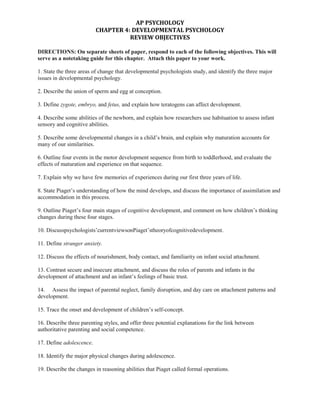
Chapter 4 review questions
- 1. DIRECTIONS: On separate sheets of paper, respond to each of the following objectives. This will serve as a notetaking guide for this chapter. Attach this paper to your work. <br />1. State the three areas of change that developmental psychologists study, and identify the three major issues in developmental psychology.<br />2. Describe the union of sperm and egg at conception.<br />3. Define zygote, embryo, and fetus, and explain how teratogens can affect development.<br />4. Describe some abilities of the newborn, and explain how researchers use habituation to assess infant sensory and cognitive abilities.<br />5. Describe some developmental changes in a child’s brain, and explain why maturation accounts for many of our similarities.<br />6. Outline four events in the motor development sequence from birth to toddlerhood, and evaluate the effects of maturation and experience on that sequence.<br />7. Explain why we have few memories of experiences during our first three years of life.<br />8. State Piaget’s understanding of how the mind develops, and discuss the importance of assimilation and accommodation in this process.<br />9. Outline Piaget’s four main stages of cognitive development, and comment on how children’s thinking changes during these four stages.<br />10. Discusspsychologists’currentviewsonPiaget’stheoryofcognitivedevelopment.<br />11. Define stranger anxiety.<br />12. Discuss the effects of nourishment, body contact, and familiarity on infant social attachment.<br />13. Contrast secure and insecure attachment, and discuss the roles of parents and infants in the development of attachment and an infant’s feelings of basic trust.<br />14.Assess the impact of parental neglect, family disruption, and day care on attachment patterns and development.<br />15. Trace the onset and development of children’s self-concept.<br />16. Describe three parenting styles, and offer three potential explanations for the link between authoritative parenting and social competence.<br />17. Define adolescence.<br />18. Identify the major physical changes during adolescence.<br />19. Describe the changes in reasoning abilities that Piaget called formal operations.<br />20. Discuss moral development from the perspectives of moral thinking, moral feeling, and moral action.<br />21. Identify Erikson’s eight stages of psychosocial development and their accompanying issues.<br />22. Explain how the search for identity affects us during adolescence, and discuss how forming an identity prepares us for intimacy.<br />23. Contrast parental and peer influences during adolescence.<br />24. Discuss the characteristics of emerging adulthood.<br />25. Identify the major physical changes that occur in middle adulthood.<br />26. Compare life expectancy in the mid-twentieth and early twenty-first centuries, and discuss changes in sensory abilities and health (including frequency of dementia) in older adults.<br />27.Assess the impact of aging on recall and recognition in adulthood.<br />28. Summarize the contributions of cross-cultural and longitudinal studies to our understanding of the normal effects of aging on adult intelligence.<br />29. Explain why the path of adult development need not be tightly linked to one’s chronological age.<br />30. Discuss the importance of love, marriage, and children in adulthood, and comment on the contribution of one’s work to feelings of self-satisfaction.<br />31. Describe trends in people’s life satisfaction across the life span. <br />32. Describe the range of reactions to the death of a loved one. <br />33. Summarize current views on continuity versus stages and stability versus change in lifelong development.<br />
